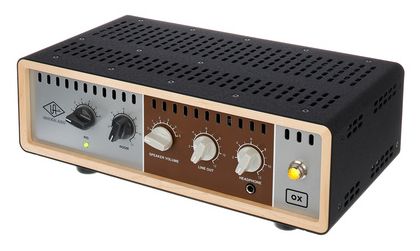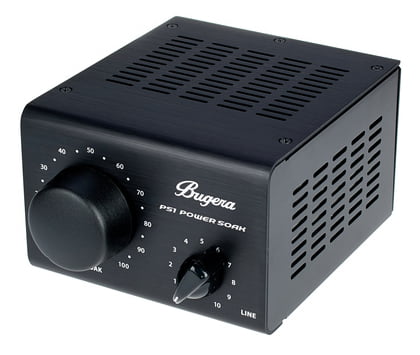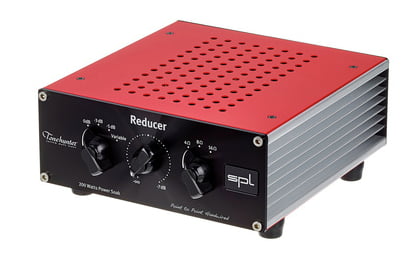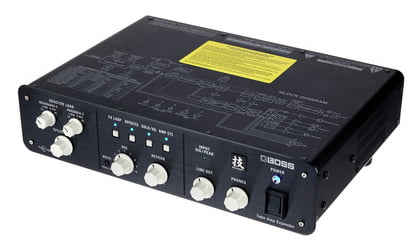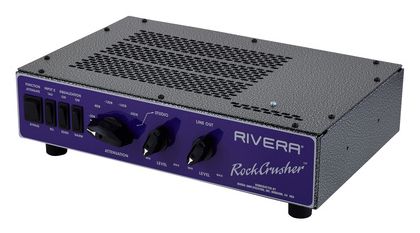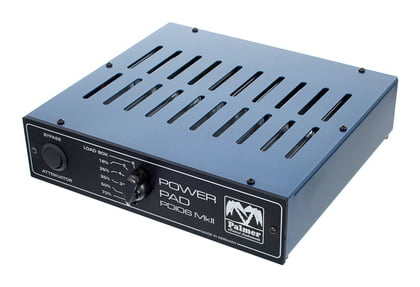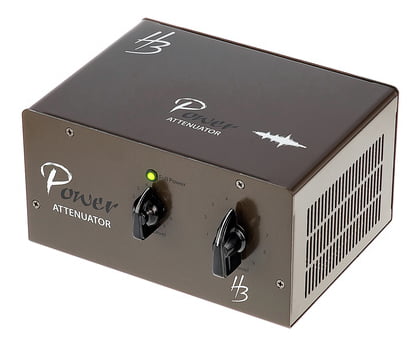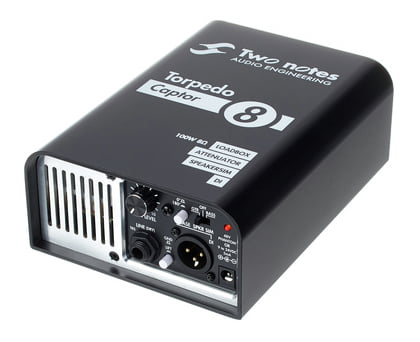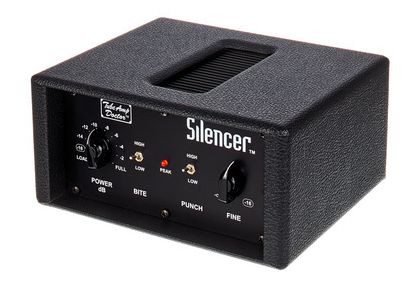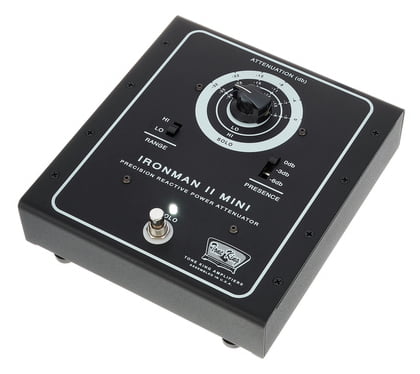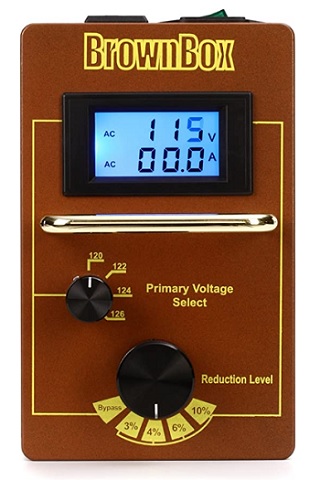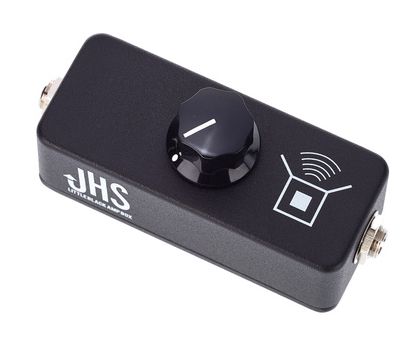In today’s installment, we’ll look at the best guitar amp attenuators you could get in 2024.
For those that don’t know, or are unsure, guitar amp attenuators are devices—placed after the power stage of an amplifier—that bleed a portion of watts to lower the perceivable volume before the signal reaches the speaker (while retaining the saturated tone the amp’s tubes provide).
Are Attenuators Safe Or Bad For Your Amp?
Attenuators are perfectly safe for your guitar amp! As long as you use the correct one for your setup. When purchasing an attenuator, you’ll need to consider your amplifier’s impedance rating—marked by a Ω symbol on the back.
The Ohm rating signifies your amplifier’s resistance to the flow of current produced and mismatching the impedance levels can adversely affect your setup—E.g., blowing the amp’s fuse. Matching impedance levels has less to do with the attenuator itself and more with the general law of electronics when connecting a load to an amplifier.
In addition, since attenuators allow you to push your amp’s output harder without hearing the effects, it can be easy to drive the tubes past their limit for extended periods. Remember that the more power you deliver to the tubes, the shorter their lifespan. But good news! The tonal sweet spot we guitarists strive for when driving a tube amp is often not found at 11.
Does An Attenuator Affect Tone & Sound Quality?
Your setup’s tone and sound quality can be affected when using an attenuator, but not for the reasons you may think. The main culprit behind the possible loss of tone is our very own ears. The very things we aim to please are often the reason behind our displeasure.
The human ear does not perceive sound equally at all volume levels. The balance of frequencies fluctuates as the volume changes. Our ears are naturally more sensitive to the mid to upper-mid range since this range is heavily relied upon for clear communication. And so, as volume decreases, so too does our perception of bass and treble frequencies.
Unfortunately, this means in an effort to look after our hearing and the hearing of others, our amp’s tone can lose some of its defining qualities at lower volumes. But all is not lost! You can adjust your signal’s frequency response post-attenuation or compensate for it pre-attenuation to retain your holy grail of guitar tones. Try what you can and see what works. Many attenuators offer tonal controls to help alleviate any tonal changes you may experience.
Why Are Attenuators So Expensive?
It comes down to the type of load the attenuator provides (mostly). Attenuators are divided into two camps: those that provide a resistive load and those that provide a reactive load.
Resistive loads are easier and cheaper to manufacture since it simply involves a series of resistors to soak your amp’s power and dissipate it as heat; many crafty individuals choose to create their own for a fraction of the cost. However, resistive loads do not mimic the characteristics of a speaker.
Capturing the characteristics of a speaker load is where the more costly reactive loads come in. Reactive attenuators use a combination of resistors, capacitors, and coils to emulate the impedance curve of a speaker load. Unfortunately, this complex design, coupled with manufacturing costs, chassis designs, and extra features, leaves little room for affordability.
The 12 Best Guitar Amp Attenuators 2024
1. Universal Audio OX Amp Top Box
If you’re a guitarist looking for more tone options and hoping to record those options in less-than-ideal locations, the OX Amp Top Box by Universal Audio may be for you. As long as you have the money to spare…
The OX is a reactive attenuator that offers much more than just attenuation. It also makes a beautiful display. And a few tonal offerings to pique the interest of guitarists looking to get sounds that may not solely be from their current setup.
Key Features:
- Setup Emulation
If you’re open to tone modeling, you can use up to twenty-two cabinets modeled after well-known cabs from Marshall, Fender, Vox, and more and up to six different microphones using the OX’s companion software.
The OX has six pre-configured setups, but you can configure your own setups using the companion software. Then, once you’ve found your guitar’s revolver of tone, you can patch them to the device for easy switching.
- Companion App
The companion app allows you to dive deep into the settings for the various rig options UA has to offer. Most of the amplifiers offered fall into the vintage classics amplifier category; unfortunately, there is no way to load third-party IRs.
However, this does help keep it easy to use since support for third-party IRs can become a very deep rabbit hole to get out of. The companion app is exclusively for macOS 10.14 Mojave or 10.15 Catalina, Windows 10 64Bit, and iOs 12/13 for iPad.
- Footswitch Assignable FX
You’ll be able to connect a 1 to 3-button footswitch to the OX and assign a varying combination of four FX to each button. The FX will be available for all six rigs. So you need to connect your footswitch, assign and edit the FX, and you’re ready to go! The four FX are a Universal Audio EQ, compressor, delay, and reverb.
Cons:
Looking at the back of the device, you’ll find three USB ports. These three ports are simply for updating the OX’s firmware, and should you have Mission Engineering’s 529 (a small USB power converter), you could power your pedals. Other than that, the three ports provide no connectivity. To connect your OX Top Box to a device, you’ll need to connect via WiFi.
Pros:
The OX’s biggest strength lies in its versatility and ease of use. It has an assortment of connections ranging from a coaxial and an optical S/PDIF Out, a Line Out, and a speaker out. So whether in a live, studio, or bedroom environment, you can count on the OX having the versatility in connections you need.
2. Bugera PS1 Power Soak
Bugera’s 100W resistive load attenuator is smaller than a shoe box, almost as affordable, and does the job with minimal features. So if you’re looking for a basic attenuator that won’t break the bank, the PS1 is a good option.
The PS1 Power Soak is a straightforward attenuator. However, in terms of quality, they vary in reliability, so you should test the unit before buying. Otherwise, find a supplier with a lengthy warranty window so you can get your money back should the worst happen.
Key Features:
- Multi-Impedance Connectors
The Power Soak covers its bases for connectivity. Depending on what you require, you have the freedom to connect the attenuator to your amplifier using a 4, 8, or a 16 Ohm input. Unfortunately, you’ll only have one speaker line out, so you won’t be able to connect multiple cabs.
- Emulated Mic Output
If you ever want/need to forego connecting to a speaker and use the PS1 as a DI, it offers a balanced XLR output that you can use to connect directly to a PA, desk, or interface. In addition, the XLR output has speaker simulation, so the tone of your guitar will be adjusted to emulate the characteristics you’d find from having a mic in front of a speaker.
Cons:
The lowest attenuation level is half the perceivable volume of the amp (i.e., 50% power is allowed to pass to the speaker). And since the Power Soak is a resistive attenuator, the tone and dynamics of your guitar won’t remain the same as the volume is attenuated.
Pros:
Since its frame is small, you can easily transport and set up the PS1 at 91 x 127 x 172 mm or 3.6 x 5.0 x 6.8″. Couple that with their lightweight (1.3kg/2.9lbs), and you have a compact attenuator that is great for gigging. And, since the PS1 is a passive unit, you won’t need to hog the outlets to set up your rig!
3. SPL Reducer
Sound Performance Lab’s Reducer gets straight to the point and does what the name implies. Unlike the pricier options we’re looking at today, the bells and whistles aren’t aplenty, but they have the potential to ring soft and true!
Sometimes small and simple is the way to go, and that’s the road traveled by this resistive load attenuator. The 200w maximum input load makes it a great option for anyone that has more power coming from their amp than they know what to do with. And if you’re looking for a similar product from SPL but with more options, you can find more from the Reducer’s bigger brother, the Cabulator.
Key Features:
- Four Position Gain Reduction Switch
You have four options for gain reduction available when using the Reducer. The positions range from 0dB, -3dB, -5dB, to a variable setting that activates the potentiometer in the center of the chassis face. The variable dial offers the most control over attenuation as it reduces the output from -7dB to complete silence. Great for when you need precise control over your volume needs.
- Three-Position Impedance Switch
Matching your amp’s impedance with the speaker’s is paramount for retaining tone and output. And isn’t that part of the reason we use attenuators in the first place? So being able to match impedance levels is a boon for setup. Thankfully, the Reducer offers the three most common impedance levels, so you don’t have to think too hard about using the attenuator with various setups.
Cons:
No gear is perfect, and despite its transparency and to-the-point design, the Reducer has a couple of downsides. First, the gain reduction isn’t consistent at all attenuation levels. It will deviate slightly depending on the impedance level selected. And second, the maximum input load also varies based on the impedance the device is set to.
Pros:
Atop a stack, combo amp, or even on a table, the Reducer won’t take up much space, making storing, transporting, and setting up this little attenuator an easy task. In addition, the little rubber feet underneath the chassis stand tall enough to clear any straps/handles on the top of your amp.
4. Boss WAZA Tube Amp Expander
The WAZA Tube Amp Expander by BOSS caters to anyone looking for more than just an attenuator. Like the OX from Universal Audio, BOSS’ reactive attenuator is brimming with features, and many of these features are aimed toward speaker emulation.
With the Tube Amp Expander, you’ll be able to direct your signal to various audio devices. From using external MIDI devices to adjust parameters on the WAZA or using the WAZA to adjust settings on an external MIDI device. You’ll even have dedicated balanced outputs for FOH and stereo outputs for recording. Otherwise, you could connect it via USB to your desktop or laptop to record directly.
Key Features:
- Variable Impedance Load
To achieve the best possible tone out of your tube amp while using the WAZA Tube Amp Expander, BOSS has added the ability to adjust the impedance response of the reactive load. There are two dials dedicated to adjusting the high and low-frequency impedance response.And should you find yourself looking at this with no idea where to start, BOSS has included a section within the manual for recommended settings based on the type of tube amp.
- Audio Interface For Guitar
The Tube Amp Expander can act as a recording interface for your guitar. They feature a 32bit AD converter, 32bit floating-point bit rate, and a 96 kHz sample rate for recording your guitar via USB. Couple the recording capabilities with their speaker emulation and FX, and you have a one-stop shop for any recording guitarist.
- FX Loop
You can connect your assortment of pedals to the WAZA’s FX loop. The device offers ground-liftable Send and Return jacks for setting up your external FX. In addition, you can adjust the reference level of the loop using a two-way switch for either -10dBu or +4dBu.
And if that wasn’t enough! You can also adjust whether your FX loop is processed as a series or a parallel loop. Series will result in only the sound of the FX being outputted, whereas parallel will mix the external effects with your direct sound.
- Rigs and Impulse Responses
By default, you’ll have access to ten pre-configured rigs to get you started with using BOSS’ expansive device. However, once you’ve connected it to your laptop/desktop, you’ll be able to load up to thirty-two third-party impulse responses to use on the go, thanks to a version 2 update.
Cons:
The features are extensive and can be difficult to wrap your head around, so taking your time to go through the features will go a long way in making the most out of this multi-faceted device. Moreover, the companion software isn’t available on mobile devices, so you won’t be able to make changes on the go. You could do so over a laptop, but doing so at a gig may not be the speediest of options.
Pros:
If your amplifier has multiple channels available, you can connect the channel-switching jack to the WAZA to hop between amp channels at the press of a button. Overall, you can expect great tones from yet another BOSS marvel.
5. Rivera RockCrusher
The Rock Crusher attenuator by Rivera is a staple among the attenuation community, and you would be hard-pressed to find it not coming up in conversation. However, that isn’t to say it’s the best, but it is a recommendation!
Rivera’s fairly large power soak has a few features that help it stand out in a line-up, and it’s because of this it garners a certain level of attention and name-dropping when one asks what attenuator they should buy.
The purple silencer uses a reactive load network and can operate as a load box should you wish to use the amplifier without a cab or connect a slave amp for further volume control.
Key Features:
- Six-Stage Attenuation Dial
Using the first five positions on the attenuation dial, you can bleed from roughly -3dB to -20dB of volume. The sixth position directs your signal to the Studio dial, which allows you to fine-tune the attenuation amount.
Values aren’t displayed for the Studio dial, but it finely adjusts the power from maximum all the way to near silence. Overall, you’ll be able to adjust your volume to fit every occasion with the RockCrusher.
- Onboard Equalization
If you’ve ever heard the frequency roll-off occur because of a substantial drop in volume, then you’ll know that having the option to boost the high and low end of your amplifier after attenuation is a godsend when attempting to save your tone.
The RockCrusher offers two two-way switches for bringing that bark and bite back to your tone. Unfortunately, if your amp has a particularly loose low-end, you may hear a tubbier tone than you would before attenuation when the warm switch is activated.
Cons:
The biggest drawback many owners can attest to is the size and weight of the RockCrusher. Transporting and setting one up may not be worth the investment, so a smaller unit is the better option if you intend to travel with your attenuator.
Pros:
Transporting and setting up the unit can be easier if you’re using racks since they are rack-mountable. In addition, you will be able to connect up to two cabs via the two parallel speaker jacks.
Couple the dual speaker jacks with the switchable 8Ω or 16Ω impedance, and you have options when deciding how to set up your RockCrusher.
6. Palmer PDI-06-16 Ohm
Much like the Power Soak by Bugera, the PD1-06 by Palmer is as simple as it gets when looking into guitar attenuation. If you are looking for an intuitive and effortless device, then the Palmer PDI-06 is for you.
They come in three separate versions: a 4Ω, 8Ω, and 16Ω unit. Each version only differs in the number of output connections. With the 4Ω and 8Ω possessing two outputs and the 16Ω one output, the version you get will depend entirely on the amp and cab you plan to connect it to.
Key Features:
- Six-Stage Attenuation Dial
On the front of the chassis, you will see an attenuation dial that can select from five different volume reduction stages. The stages range from 18% reduction to up to 70% volume reduction.
Should you wish to forego using a cab, a sixth stage turns the device into a load box that fully absorbs the wattage for silent recording, passing your signal onto a slave amp, or for direct connection to a mixer or interface.
- Bypass Button
If you ever need to ditch attenuation and use the full force of your tube amp, you’ll have a bypass button beside the attenuation dial for a quick switch. However, you need to have speakers connected to the device to ensure you do not damage your amplifier.
Cons:
If the PDI-06 catches your eye and you’re wondering about speaker emulation, unfortunately, you’ll have to shell out extra to purchase a PDI-09 to set up alongside the 06. Palmer opted to manufacture two individual units for attenuation and speaker emulation so that those looking for one or the other could get what they’re looking for.
Pros:
The device is really easy to set up and use. If you are connecting it to a combo tube amp, you’ll have slightly more work ahead of you, but once you’ve done the initial setup, the PDI-06 is just a dial turn away from fulfilling your attenuation needs. In addition, they are fairly affordable compared to other attenuators on the market, so if you’re on a budget, they are a good choice.
7. Harley Benton PA-100 Power Attenuator
Harley Benton’s PA-100 is an attenuator that is as straight to the point as a military drill sergeant, but your signal won’t be as loud after it’s done with your amp. This compact box offers what you need, and it does it well!
The resistive load power soaker uses passive circuitry, so you won’t need to supply any power to the unit when using one, and they retain a transparent tone rather well. You may find some loss of high-end as you attenuate the signal near to silence, but that is to be expected when lowering any sound.
Key Features:
- Multiple Impedance Inputs
If you find yourself using cabs with varying impedance levels or just like the idea of having your options open, the PA-100 offers an input jack for three standard impedance levels. So whether you’re practicing with a 4Ω combo amp, recording with an 8Ω stack, then gigging with a 16Ω stack, the PA-100 can adapt.
- Three Separate Outputs
With an output for every occasion, you can rest easy knowing Harley Benton’s attenuator is as simple to set up as it looks. They offer two Line Outs, one for connecting to an external FX processor or a slave amp and another for connecting to your cab. In addition, you have an XLR Out with speaker simulation for connecting to a desk or interface.
Cons:
The maximum input of 100w may not hold up well if you use a 100w amplifier, so for those with big toys; you’ll need to find an attenuator with a higher maximum input. Ideally rated to twice your amp’s power. But if you don’t mind the attenuator getting scolding hot on you, you can use one slightly over your amp’s power rating.
Pros:
The bite-sized power soak is an affordable option compared to many attenuators on the market, especially since it can also be used as a load box for silent recording.
8. Two Notes Torpedo Captor 8 Ohms
The Torpedo Captor by Two Notes is a passive, reactive load attenuator that provides features that cater ever so slightly more toward recording guitarists. Specifically, recording guitarists that have a thirst for speaker simulation. If that sounds like you, then read on.
They are manufactured to set impedance levels of 4, 8, and 16Ω, so you must determine which version you need before purchasing. Compared to many of the attenuators on the market, Two Note’s attenuator doesn’t seem like much of an attenuator since the features and connections rely heavily on the device’s ability to offer adjustable simulated speakers.
Key Features:
- Guitar DI
You’ll be able to use the Captor to connect your amp to a mixer or interface directly. You must power it via a 9-12 DC supply or phantom power.
The DI functionality extends to a phase button for flipping the phase of the signal 180° should you need to and a ground lift switch should you need to alleviate the pains of any ground loops, etc.
In addition, there is a Thru Output for connection to a speaker, so you can use your cab for monitoring while FOH receives a direct signal.
- Speaker Simulation
The Torpedo Captor’s strengths lie more in speaker simulation. The unit comes with a preset speaker sim—for guitar and bass—that can be activated via a three-way switch for the XLR Output.
In addition, Two Notes provide their free Wall of Sound III plug-in for adjustable Impulse Responses. Based on Two Note’s Le Preamp pedals, the onboard speaker sim preset is not adjustable, but their provided plug-in offers up to 16 IR Cabinet simulations.
Cons:
More control over the attenuation amount would have expanded its uses. You will have to make do with a set attenuation limit if you buy the Torpedo Captor—which is less than ideal unless you find that -20dB is perfect for getting your tube amp to an acceptable level while still retaining the characteristics you enjoy hearing when you play.
I highly recommend you test the unit before purchasing to determine whether this is the right one for you.
Pros:
The impulse responses provided offer great preset tones to choose from when recording, and they are customizable, so you can craft your desired guitar setup in the studio right from your DAW.
Admittedly, they don’t capture the same qualities you would find from a speaker moving air, but they come close enough that the Torpedo Captor can be your ally if you need to do a silent recording session.
9. Tube Amp Doctor Silencer
Tube Amp Doctor’s Silencer is a resistive load attenuator that hits the nail on the head regarding product names. Whether you want a quieter tube amp or a silent one, the Silencer can help you achieve either, and it’ll look good doing it!
I recommend that 100w tube amp owners and vintage amp owners look at the Silencer for their attenuation needs. Attenuating high-power amplifiers can be tricky since the excess power is dissipated as heat, and attenuation units tend to heat up fairly easily.
Power soakers with higher maximum inputs don’t need to work as hard to dissipate that excess power which means a cooler time overall.
Key Features:
- EQ Compensation
To make up for our ear’s varying perception of frequencies based on volume, you have access to two three-way switches for boosting the high and low end of your tone by a set amount of +6dB. If you want to retain a tone that, after attenuation, cuts through a mix like a hot knife through butter and punches like a heavyweight boxer, then EQing the signal is a must.
- Tube Amp Doctor’s FANTA Speaker Sim
You’ll be able to send your signal to a mixer or interface via an XLR Out. The balanced connection features TBD’s Frequency Adapted Natural Tone Accessory for maintaining that speaker-esque tone when connecting directly to a PA or recording device.
The speaker sim reacts to the fundamental tone and adjusts accordingly. Based on the signal you feed the attenuator, clean tones become slightly compressed and brighter, and distorted tones have a punchier, smoother overall sound with some weight in the deep bass.
Cons:
You may have difficulty setting the Silencer up if you plan on placing it on your amp head. The chassis doesn’t have any feet to provide clearance for straps and their dimensions are fairly large: 245x120x200mm (9.6×4.7×7.78″)
Pros:
The 4, 8, and 16Ω versions can handle a power input of up to 150w, which is good for anyone with an amplifier close to 100w power output. Especially for vintage amp owners since vintage amps produce a higher power output than stated on the chassis.
10. Koch Amps LB120-II/8
The rack-friendly LB120 II by Koch Amps sports multiple features useful for any gigging or recording guitarist. You’ll have several options for deciding where and how your amp’s signal is transported.
The assortment of jack inputs and outputs make the LB120-II a head-scratcher at first glance, but once you’ve figured it all out, it becomes a reasonably priced option that produces great results. Of course, whether the signal transparency holds up to your standards will be entirely up to your ear, so if you can test one out, I highly recommend it!
Key Features:
- Attenuated Outputs
On the front of the well-ventilated chassis, you’ll find a row of female jack outputs labeled with a percentage above. Each connection is hardwired to provide an attenuated signal. Six different signal levels are available: 100%, 40%, 15%, 5%, 2%, and 1% of the signal’s power rating. Once you’ve connected your speaker to the output of your choice, you’re ready to go. As simple as that!
- Two Adjustable Speaker Sim Outputs
If you’re open to speaker-simulated outputs, the LB120-II offers a balanced XLR and an unbalanced Line Out with speaker-sim options. You’ll be able to adjust two characteristics of the simulated speaker tone: mic position and cab type.
You can switch the mic position between an on and off-axis response depending on whether you’d like a brighter or a darker tone. And the cab type options are either a single 12″ or a 4×12 cab. Tonally you can expect a response similar to a Marshall cab.
- Multi-Cab Support
Koch Amps have your back covered for those who use multiple cabs in your rig. You can patch the attenuated signal to a dual cab section on the device. So depending on the impedance of the attenuator, you can connect your wall of sound and hear its saturated goodness at a more socially acceptable level.
Cons:
The LB120-II is sold in separate impedance ratings, so if your setup’s impedance tends to hop around because of gig venue equipment or practice setup preferences, this may not be the attenuator for you unless you don’t mind buying multiple attenuators at different impedance levels.
Of course, the biggest caveat would be the hardwired attenuation levels since you will need to turn off your amp and disconnect it whenever you want to adjust attenuation levels.
Pros:
Should you wish to connect a slave amp or record directly without the speaker sim, you are given an unfiltered Line Out and a pad Line Out. In addition, the maximum input power is rated at 120w, so vintage amp owners can breathe easily, knowing they have some room to spare. And lastly, you can connect headphones to the device when you want to monitor it directly.
11. Tone King Ironman II Mini Attenuator
If the keywords in your search for an attenuator include: portable, simple, and intuitive, the Ironman II Mini is the one for you. Smaller than the size of a comic book and about as thick as MXR’s Distortion+, the Ironman II Mini embodies its name.
Unlike the attenuators that precede the Mini on this list, Tone King’s smaller version of the Ironman II is aimed towards those who own tube amps with a considerably low power rating: the maximum input they can handle comes in at 30w. Unfortunately, these 30w attenuators are limited in impedance as they are built for 8Ω only.
Key Features:
- Three Stages of Attenuation
Overall, the Ironman Mini offers eighteen attenuation levels to choose from. These eighteen levels are split into six amongst three stages: solo, hi, and lo. The solo stage is activated using a footswitch on the attenuator and provides the least attenuation: from 0dB to -32dB.
And lo offers the highest amount of attenuation: -6 to -38dB. Hi falls in between the two. This design allows you to set a level for rhythm playing and easily switch to a different level for guitar solos.
- Presence Reduction Switch
To help you retain a desirable tone in hard-surfaced venues/rooms, you can lower the upper-mid range using a three-way switch. The switch positions go from 0dB to -3dB to -6dB. So should your tone become sharp and piercing on the ear within the space you’re in, a simple flick of the switch can help.
The presence reduction can also benefit your tone when reducing your amp’s output for home use. It won’t be the magic bullet that makes it sound exactly how it would sound at higher volumes, but it can be the bandaid you may need.
Cons:
The Solo switch has an LED, indicating whether it is active. You will need a set of AA batteries or a 9v power supply to light it up. So you’ll need to keep batteries on hand or the power supply in your gig bag if you want to take the guesswork out of the solo switch.
Pros:
You can connect to external gear other than a speaker via two outputs. One is a Line Out for amp slaving or connecting to an external FX processor, and the other is an XLR Out for connecting to a mixer, interface, or PA system.
Extra:
1. AmpRX BrownBox Tube Amplifier Input Voltage Attenuator
AmpRX’s BrownBox is a unique little attenuator that specializes in adjusting the main power input for your amp. They are a great investment for ensuring the lifespan of your amp’s tubes is as long and as consistent as possible, especially if you’re a gigging guitarist.
In an ideal world, all the outlets we connect our gear to will provide consistent power supplies and were originally setup up to code. However, this isn’t always the case, and when it comes to tube amps, inconsistencies in the voltage supply can adversely affect the tubes we love. Inconsistent voltage supplies are where the BrownBox comes in.
Key Features:
- Voltage Attenuator
The little step-down voltage attenuator does one thing and one thing only. It lowers the voltage you receive from an outlet before you connect your amplifier. A small LED display indicates the supplied voltage.
Outlets tend to fluctuate in the amount of voltage they supply, so by using the BrownBox to lower the inconsistent voltage levels to an ideal range, you can achieve a more desirable tone and prolong the life of your amp’s tubes.
Cons:
Unfortunately, AmpRX’s BrownBox can only attenuate the voltage in steps of -3%, -4%, -6%, and -10%. Also, the range can still fluctuate, so it won’t limit the voltage to a specified amount.
Pros:
AmpRX has multiple versions of their BrownBox, so if your country uses a different voltage standard, you can still get a piece of this pie by looking at their BrownBox II, Eurovolt, Backline 1200, and Backline 2400. The Backline series are rack-mountable voltage attenuators that offer multiple amplifier power inputs.
2. JHS Little Black Amp Box Passive Amp Attenuator
If a controlled volume is what you’re after, but a standard attenuator is either too expensive or unappealing, then the Little Black Amp Box by JHS Pedals might be what you’re after. It’s small and fits right into your FX Loop; what more could you need?
Unlike the power stage saturation, a standard attenuator allows you to achieve at lower volume levels. JHS’ black box will allow you to achieve preamp saturation at a more socially acceptable volume.
By turning the signal’s level down after it passes the amplifier’s preamp, you’ll be able to turn the amp’s preamp level up exceptionally higher without receiving the exceptionally high volume that comes with it. However, the power tubes won’t receive a hot enough signal to saturate.
Key Features:
- Volume Control
The main aim of the LBAB is to adjust the volume of your amplifier once it has gone through the preamplification stage. By connecting to an amp using its Send and Return FX loop, the LBAB receives your guitar’s preamplified tone and turns it down before it reaches the power amp stage of the tube amp.
Cons:
It is important to note that the Little Black Amp Box does not produce the same results as a standard attenuator. Since it is designed to be placed into your amp’s FX loop, the power stage of your tube amp will not have the level required to create that natural tube breakup tube amps are prized for.
Pros:
If your amplifier doesn’t have a master volume control, the Little Black Box can be a great addition to get finer control over your volume. On the other hand, if you want more control of a high-gain amplifier and how much preamp saturation you can achieve, JHS’s little creation is a viable option.
Conclusion
Whether you’re looking for pure attenuation or attenuation and more, there is one for you here. And if not, you could make your own if you have the knowledge, the time, and the money to do so.
They are an invaluable investment for tube amp owners since, without one, it may be difficult to enjoy the true tone of your tube amp unless you’re lucky enough to have the kind of environment to set it free. But then you wouldn’t be here now, would you?
The ways we could divide this list are many, so to keep it short and sweet, we’ll look at the abundance of features offered alongside attenuation since you may have noticed if you read through it all, that many of the products available today offer more than just attenuation and some lean heavily to speaker sim and IRs despite being called attenuators.
If you are looking for a simple attenuator that does just that, then the ones to look at are the Reducer by SPL and the PDI-06 by Palmer. They are about as simple as they come and are the cheaper options available.
Suppose you want extra functionality regarding available outputs, onboard EQ, and speaker simulation. In that case, the PS1 by Bugera, RockCrusher by Rivera, PA-100 by Harley Benton, LB120-II by Koch Amps, and the Ironman II Mini by Tone King are your batch of candidates.
If in your book more is more, the OX Amp Top Box by Universal Audio and Waza Tube Amp Expander by BOSS offers a vast range of features alongside attenuation. However, they are really pricey. And this is justifiable since they essentially offer a complete guitar recording suite that allows you to enjoy your tube amp in a multitude of ways without bothering a soul.
As for the extras for today, the BrownBox by AmpRX is a fantastic investment for prolonging the life of your amplifier’s tubes and ensuring your amp is being supplied the power it requires to operate within its lane.
This product is a must-buy if you own a vintage tube amp! The Little Black Amp Box by JHS can help keep your overall volume low, but you wouldn’t achieve that desired tube amp saturation that an attenuator provides.

A part-time sound engineering lecturer and musician based in Pretoria, South Africa. He has had a passion for all things music since he was big enough to sit on his cousin’s bed and strum away on an old guitar. All while his uncle, in a room below him, stood with a broom in hand and drummed along on the ceiling. When he isn’t teaching others the basics of sound theory, how to record, and how to mix, you can find him sitting with a guitar fiddling away, completely lost to the world.


